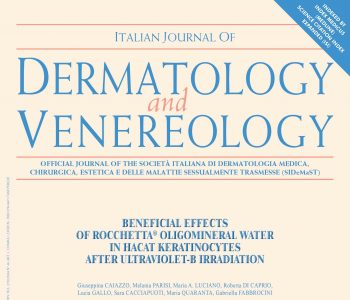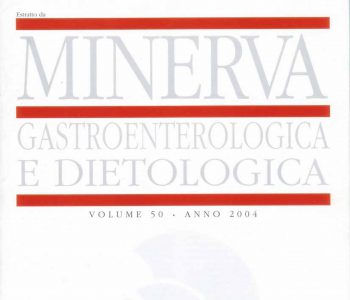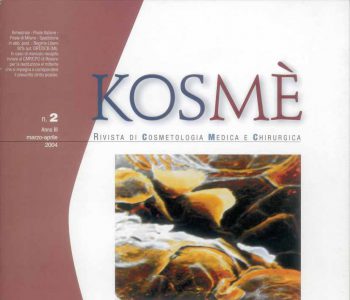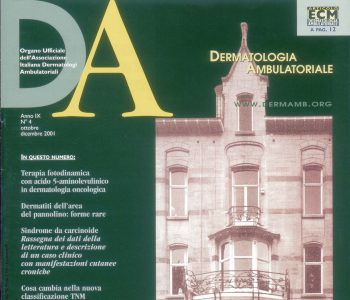Abstract
Despite the well-known cutaneous beneficial effect of thermal water on the skin, no data exist regarding the potential biological effect of orally consumed water on healthy skin. Thus, in this single-center, double-blind, randomized controlled clinical trial conducted on age and menstrual cycle timing-matched healthy female volunteers (24 + 24) consuming water A (oligo-mineral) or water B (medium-mineral) for 1 month (T1), the cutaneous lipidomics were compared. Interestingly, only water A consumers had a statistically significant (p < 0.001) change in cutaneous lipidomics, with 66 lipids different (8 decreased and 58 increased). The cutaneous lipidomics of consumers of water A vs. water B were statistically different (p < 0.05). Twenty cutaneous lipids were necessary to predict the water type previously consumed (AUC ~70). Our study suggests that drinking oligo-mineral water may change skin biology and may influence the cutaneous barrier, so future dermatological clinical trials should also account for the water type consumed to avoid potential confounders.
1. Introduction
Ablutions in thermal water are an ancient treatment for several dermatological disorders refractory to the poor topical pharmacopeia that shamans, healers, alchemists, surgeons and doctors worldwide adopted.
Preliminary in vitro studies on keratinocyte cultures suggested antioxidant, anti-angiogenic and anti-inflammatory properties clinically interpreted as a global anti-senescence effect in healthy skin. Furthermore, these characteristics are also beneficial as a complementary contact treatment for pathological cutaneous conditions, ranging from inflammatory (i.e., psoriasis) to allergic (i.e., atopic dermatitis). Using modelling, Caiazzo et al. recently evaluated the effect of daily ultraviolet cutaneous exposure in HaCaT keratinocytes, finding that oligo-mineral water was protective and limited UVB-related pro-inflammatory effects.
Water can also be classified using the fixed residue (fd) of mineralized, oligo-mineral, mineral or medium-mineral, and highly mineralized (see Section 2.1.1. for more details). Fd contributes to the taste of water and, consequently, also to consumer preferences; for example, in Italy, >90% of the water consumed daily belongs to the oligo-mineral and medium-mineral categories.
Interestingly, evidence for the potential cutaneous effects of water consumed orally is widespread and seldom discordant, especially in healthy subjects. Moreover, encouraging results are displayed in patients with atopic dermatitis.
Although no linear correlation has been proved between water intake and skin hydration, some studies sustained that proper water intake may also marginally improve skin hydration in healthy patients. Remarkably, water is still regarded as an inert drink, not meritorious to be standardized in nutritional, as well as clinical, studies, in plenty contradiction to its effect on vessels.
Thus, we decided to design a clinical trial to evaluate the effect of different water types on skin biology in healthy patients.
2. Materials and Methods
2.1. Study Design
This is a single-center, double-blind (subject and investigator), randomized controlled clinical trial conducted on healthy volunteers. The study includes age and menstrual cycle timing-matched female subjects who blindly consumed water A or water B, both marketed as food and not supplements. The enrolled subjects were asked to drink 2 L of water of the assigned type (water A or water B) per day.
At the baseline (T0) and after 1 month (T1), patients (a) were clinically evaluated independently by two board-certified dermatologists (>5 years of experience), (b) performed complete blood count (CBC), creatinine and physical (macroscopic) chemical urine tests, and (c) collected a skin stripping with Patch Sebutape®.
The study fulfilled the Helsinki Declaration and the General Data Protection Regulation 2016/679, so it was approved by the Institutional Review Board of San Raphael Hospital (protocol code: 176/INT/2020 and date of approval: 11 November 2020). All participants signed an approved informed consent form.
2.1.1. Mineral Water Evaluation
Waters were classified in accord with the Marotta & Sicca classification of Italian mineral waters that remains the parameters required by Italian law to market mineral waters (see D.Lgs. 25.01.1992 n°105 and D.Lgs. 176/2011) [17]. The parameters evaluated in the algorithm are temperature, fixed residue (fd) and chemical composition. With respect to the temperature, mineral waters can be divided into (a) cold, with a temperature < 20 °C; (b) hypothermal, with a temperature between 20 °C and 30 °C; (c) homeothermal or simply thermal, with a temperature between 30 °C and 40 °C; and (d) hyperthermal, with a temperature > 40 °C. With respect to fd, mineral waters are differentiated by the categories: (a) mineralized, with fd < 50 mg/L; (b) oligo-mineral, with fd < 500 mg/L; (c) mineral or medium-mineral, with fd between 500 and 1000 mg/L; and (d) highly mineralized, with fd > 1500 mg/L. Then, based on the chemical composition of the fixed residue, thermal water derives its name from the element or set of elements from which it is formed. Parameters important in this phase are the main anion (or anions) and main cation; when an ion is present in quantities greater than 20 mEq/L, it gives the name to the water. Based on the prevailing ionic composition, mineral waters are classified into (a) bicarbonate, (b) sauce or chloride-sodic, (c) sulfuric, (d) ferruginous, (e) arsenicated and (f) sulphated.
Notably, chemical analyses of water A (bicarbonate-calcic oligo-mineral, marketed as Rocchetta water) and B (bicarbonate-calcic medium-mineral) are reported in Supplementary S1.
2.2. Inclusion and Exclusion Criteria
We enrolled (a) female subjects, (b) aged between 30 and 50 years, (c) in good health (absence of pathologies that have an International Classification of Diseases (ICD) code in compliance with the definition of the World Health Organization: “a state of complete physical, mental and social well-being and not merely the absence of disease or infirmity.”), (d) omnivores [18,19,20,21,22,23], (e) Italian native speakers, (f) who signed the informed consent form.
Conversely, subjects were excluded if they were/had (a) males; (b) in a different age range (<30 and >50 years of age) or with a Body Mass Index (BMI) < 19 or >30; (c) active or latent inflammatory, oncological and rheumatological diseases; (d) menopausal/gynecological disorders (i.e., dysmenorrhea); (e) chronic dermatoses (i.e., psoriasis or even a transitory dermatosis in the previous 6 months); (f) allergic disorders (i.e., asthma [24], atopic dermatitis [25,26] or multiple chemical sensitivity (MCS) [27]); (g) a different diet than omnivore, included fasting; (h) active renal/urological disorders, or even a history thereof; (i) refused to sign the informed consent form.
2.3. Dermatological Evaluation
Medical histories were carefully collected by two Italian, experienced (>5 years of experience in university hospitals), board-certified dermatologists (G.D. and P.P.). Clinical and dermatoscopic evaluations were performed at T0 and T1.
Dermatologists also administered the Skin Satisfaction Questionnaire (SSQ) at T0 and T1 to the enrolled subjects [28].
2.4. Sample Processing
The cutaneous sample was obtained with Patch Sebutape® (Cantabria Labs, Varese, Italy) placed on the cleansed (micellar water + clorexidin 2%) glabella region for 30 min, and after removal, it was stocked in a 13 mL vial. Then, we added 5 mL dichloromethane:methanol (2:1), and the vial was shook for 15 s with a vortex. We performed a sonication for 5 min and a centrifugation at 4000 rpm for 10 min at 15 °C on the solution of the organic phase, which was transferred to an Eppendorf tube and concentrated under nitrogen flow until the extract was completely dry. The residue was centrifuged for 5 min at 4000 rpm at 15 °C, and the supernatant was collected and finally analyzed. At the same time as the analysis of the samples, QC samples obtained by taking and combining 15 µL of each extracted sample were prepared and analyzed.
2.5. High-Resolution Mass Spectrometry Analysis (UHPLC-HRMS)
All samples were analyzed at UNITECH OMICs (University of Milano, Italy) using an ExionLC™ AD system (SCIEX, AB Sciex Pte. Ltd., Singapore) connected to a TripleTOF™ 6600 System (SCIEX, AB Sciex Pte. Ltd., Singapore) equipped with a Turbo V™ Ion Source with an ESI Probe. The software used was SCIEX OS version 3.1 (AB Sciex Pte. Ltd., Singapore).
Chromatography of the Skin Strips
The chromatographic separation on a Kinetex® EVO C18—2.1 × 100 mm, 1.7 μm (Phenomenex, Torrance, CA, USA) equipped with a precolumn was achieved using, as mobile phase A, water/acetonitrile (60:40) and, as mobile phase B, 2-propanol/acetonitrile (90:10), both containing 10 mM ammonium acetate and 0.1% of formic acid. The flow rate was 0.4 mL/min, and the column temperature was 45 °C. The elution gradient was set as 0–2 min (45% B), 2–12 min (45–97% B), 12–17 min (97% B), 17–17.10 min (97–45% B) and 17.10–20 min (45% B).
3. Results
3.1. Clinical Data
In the present clinical trial, 48 (24 + 24) female subjects were enrolled, and their mean age was 44.7 ± 2.6 years of age. No age differences were detected between Water A and Water B drinkers. The average BMI of the enrolled patients was 24.3 ± 2.6 kg/m2 (64.6 ± 8.1 kg), with no difference between the two considered groups (p < 0.05).
SSQ globally improved in both groups, but in a non-statistically significant manner (p > 0.05); interestingly, subjects that consumed Water A manifested a statistically significant decrease of SSQ from T0 to T1.
3.2. Differences in Cutaneous Lipidomics between the Two Groups Drinking Different Waters
Interestingly, after 1 month, only patients that consumed Water A displayed a change in cutaneous lipidomics. In total, 66 lipids registered a statistically significant change (p < 0.001): 54 Glycerolipids (18 Diacylglycerols (DG), 12 EtherDG, 24 Triacylglycerols (TG)), 8 Glycerophospholipids (5 Lysophophatidylcholines (LPC), 3 Phosphatidylcholines (PC)), 3 Sphingolipids, 1 Hexosylceramide hydroxyfatty acid-sphingosines (HexCer_HS), 1 Sphingosine (Sph), 1 Sphinganine (DHSph) and 1 Fatty acyls (1 Acylcarnitine (CAR)). Overall, 8 glycerolipids decreased (6 TG and 2 DG), and the others increased.
Subjects who consumed Water B did not display any statistically significant change in cutaneous lipidomics.
Comparing the T1 lipidomics in the two groups, the difference was nearly statistically significant, so we further evaluated the data with Principal Component Analysis.
4. Discussion
In this clinical trial, we demonstrated that water orally consumed had an effect on skin lipidomics; oligo-mineral water has a prominent effect on cutaneous biology if compared with the medium-mineral one.
Some evidence evaluated the biological effect of water consumed orally on dermatologically healthy patients, but it focused mainly on cerebral circulation or on pathological skin. These aspects, together with the biologically relevant effect of oligo-mineral water, suggest that researchers should carefully mention the water type in the inclusion/exclusion criteria in observation studies and clinical trials examining nutrition in dermatology and urology.
Ideally, studies should include the water type orally consumed in the exposome to modify the cutaneous outcomes, especially in complex skin disorders, in which susceptible genes [29,30] interact with exposure to manifest the pathological phenotype (i.e., psoriasis or hidradenitis suppurativa) [31,32]. In fact, exposures may condition the epigenetics that modulate genes expression [33] and even drug response [34].
From this perspective, the water ingested should be regarded as a supplement, or even a drug, that synergically collaborates with drugs to improve the clinical outcome. The present evidence may also sustain, with solid evidence, that the water type orally consumed should be reported in the medical history, or even included as a part of the therapeutical prescription. This concept should also be shared with patients, who often ask their doctor for diet and dietological suggestions to improve their skin quality. Nowadays, our data contributed to the literature to solve doubts regarding the potential modulation of skin biology that water induced; yet, at the same time, the data maintained that water is an active principle and factor to be considered in science and therapy.
In healthy patients, oligo-mineral water displayed a prominent effect in restoring the cutaneous barrier, as previously suggested in atopic dermatitis patients [13]. From this point of view, oligo-mineral water should always be supplemented in the case of barrier dysfunction or even allergic disorders.
At the same time, in line with Caiazzo et al.’s findings, our results could also suggest a direct effect on the skin microbiome capable of positively influencing the skin barrier and its lipidomics. Future efforts should be focused on a better understanding of the biological dynamics occurring between the cutaneous microbiome and keratinocytes biology. To confirm our data, omics and machine learning were able to magnify the water-based changes in cutaneous lipidomics and may project clinicians into the new future led by precision medicine.
Despite the innovative design (omics and machine learning) the present clinical trial also has some limitations, such as the inclusion of solely female subjects between 30 to 50 years of age. Thus, future studies should also validate these results in different ages, males and even diets.
5. Conclusions
Water orally consumed has a remarkable effect on the skin lipidomics in healthy subjects, so especially oligo-mineral water should be regarded as a complementary therapy in dermatological disorders. Furthermore, clinical trials evaluating nutritional supplements or diets in dermatology should account also for the water type consumed. Thus, water has to be regarded as a supplement for its biological effect on skin.
Author Contributions
Conceptualization, G.D.; methodology, G.D. and H.A.-S.; software, H.A.-S.; validation, G.D., I.C. and H.A.-S.; formal analysis, H.A.-S.; investigation, G.D., I.C. and H.A.-S.; resources, P.D.M.P.; data curation, P.D.M.P.; writing—original draft preparation, G.D.; writing—review and editing, G.D., I.C., H.A.-S. and P.D.M.P.; visualization, H.A.-S.; supervision, P.D.M.P.; project administration, G.D. and I.C.; funding acquisition, P.D.M.P. All authors have read and agreed to the published version of the manuscript.
Funding
This research was partially funded by CoGeDi International SpA.
Institutional Review Board Statement
The study was conducted according to the guidelines of the Declaration of Helsinki and approved by the Institutional Review Board of San Raphael Hospital (protocol code: 176/INT/2020 and date of approval: 11 November 2020).
Informed Consent Statement
Informed consent was obtained from all subjects involved in the study.
Data Availability Statement
The data are available in a publicly accessible repository.
Acknowledgments
Part of this work was carried out in OMICs, an advanced mass spectrometry platform established by the Università degli Studi di Milano. We thank Fiorenza Fare and Donatella Caruso for their assistance.
Conflicts of Interest
The funders had no role in the design of the study; in the collection, analyses, or interpretation of data; in the writing of the manuscript; or in the decision to publish the results. Paolo Pigatto received a research grant from CoGeDi International SpA and SIDeMaST (Italian Society of Medical, Surgical, Aesthetic Dermatology and Sexually Transmitted Diseases).







